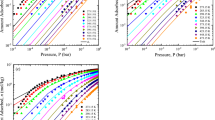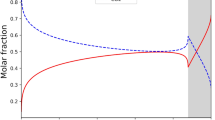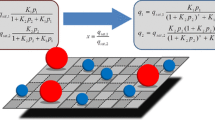Abstract
Adsorption isotherm data of methanol, ethanol, and dimethyl carbonate were determined via headspace experiments on two activated carbons (RB 4 from CABOT Norit and SC 40 from SilCarbon) at different temperatures. However, dimethyl carbonate (DMC) showed a significant decomposition to methanol and CO2 during the adsorption experiments. Hence, the measured isotherm data for DMC were always two-component isotherm data assuming CO2 as non-adsorbing component. Thus, ideal adsorbed solution theory (IAST) was inverted to determine the single-component isotherm of DMC using two-component isotherm data and the known single component isotherm of methanol. The inverse IAST was supported by the calculation of the adsorption equilibrium distribution. This calculation was done with the expectation maximization method and results were used to determine the most probable isotherm equations to initialize the inverse IAST calculation. The methodology was validated for mixtures of methanol and ethanol where both single-component isotherms were known. Finally, single-component isotherms were calculated for DMC on RB 4 and SC 40 at different temperatures.







Similar content being viewed by others
Abbreviations
- AED:
-
Adsorption energy distribution
- AEqD:
-
Adsorption equilibrium distribution
- DMC:
-
Dimethyl carbonate
- EM:
-
Expectation maximization
- EMC:
-
Ethyl methyl carbonate
- EtOH:
-
Ethanol
- IAST:
-
Ideal adsorbed solution theory
- MeOH:
-
Methanol
- b i :
-
Langmuir coefficient of binding site i, L mmol−1
- c :
-
Coefficient for power function describing separation factor, Ld mmol-d
- d :
-
Coefficient for power function describing separation factor, 1
- E A :
-
Adsorption energy, J mol−1
- f :
-
Adsorption equilibrium distribution, mmol g−1
- H i :
-
Henry coefficient of binding site i, L g−1
- I i :
-
Integral, mmol g−1
- K 0 :
-
Pre-exponential factor, L mmol−1
- K :
-
Binding coefficient, L mmol−1
- m AC :
-
Mass of adsorbent, g
- M :
-
Molar mass, g mol−1
- n add :
-
Initial amount of adsorptive, mol
- R :
-
Universal gas constant, J mol−1 K−1
- R ′2 :
-
Fictive regression coefficient, 1
- S X :
-
Weighed linear deviation between experimental and calculated loading, 1
- S I :
-
Weighed linear deviation between the IAST integrals, 1
- S :
-
Sum of SX and SI, 1
- TSS X :
-
Total sum of squares of deviation between experimental and calculated loading, 1
- TSS I :
-
Total sum of squares of deviation between the IAST integrals, 1
- TSS :
-
Sum of TSSX and TSSI, 1
- T :
-
Temperature, K
- V vial :
-
Volume of the vial, m3
- y i :
-
Mole fraction of component i in the gas phase, \({\text{mol}}_{i} \,{\text{mol}}_{\text{total}}^{ - 1}\)
- Y i :
-
Gas loading of component i, mmol L−1
- Y′i :
-
Corrected gas loading of component i, mmol L−1
- Y min :
-
Minimum gas loading of an experimental isotherm, mmol L−1
- Y max :
-
Maximum gas loading of an experimental isotherm, mmol L−1
- Y overall :
-
Overall gas loading, mmol L−1
- x i :
-
Mole fraction of component i in the adsorbed phase, \({\text{mol}}_{i} \,{\text{mol}}_{\text{total}}^{ - 1}\)
- \(x_{i}^{0}\) :
-
Mole fraction of pure component i in the adsorbed phase if no other substance was present, \({{{\text{mol}}_{i}}} \,{{{\text{mol}}_{\text{total}}}^{ - 1}}\)
- X i :
-
Adsorbent loading of component i, mmol g−1
- X inverse IAST :
-
Adsorbent loading of pure component calculated by inverse IAST, mmol g−1
- X cal :
-
Calculated loading, mmol g−1
- X mon :
-
Monolayer capacity, mmol g−1
- X IAST :
-
Overall loading of the adsorbent by IAST, mmol g−1
- \(X_{i}^{0}\) :
-
Pure component loading if no other substance was present, mmol g−1
- X′i :
-
Corrected adsorbent loading of component i, mmol g−1
- α :
-
Separation factor, mol mol−1
- π :
-
Spreading pressure, kg m−1 s−2
- ρ A :
-
Buoyancy density, kg m−3
- ϑ :
-
Temperature, °C
- ϑ B :
-
Boiling temperature, °C
- θ :
-
Local isotherm model, 1
References
Ebadi, M., Brandell, D., Araujo, C.M.: Electrolyte decomposition on Li-metal surfaces from first-principles theory. J. Chem. Phys. 145(20), 204701 (2016). https://doi.org/10.1063/1.4967810
Felinger, A., Zhou, D., Guiochon, G.: Determination of the single component and competitive adsorption isotherms of the 1-indanol enantiomers by the inverse method. J. Chromatogr. A 1005(1–2), 35–49 (2003). https://doi.org/10.1016/S0021-9673(03)00889-6
Forssén, P., Lindholm, J., Fornstedt, T.: Theoretical and experimental study of binary perturbation peaks with focus on peculiar retention behaviour and vanishing peaks in chiral liquid chromatography. J. Chromatogr. A 991(1), 31–45 (2003). https://doi.org/10.1016/S0021-9673(03)00213-9
Golshan-Shirazi, S., Guiochon, G.: Comparative evaluation of adsorption energy distribution functions obtained by analytical and numerical methods. J. Chromatogr. A 670(1–2), 1–14 (1994). https://doi.org/10.1016/0021-9673(94)80275-0
Gritti, F., Guiochon, G.: Effect of the surface heterogeneity of the stationary phase on the range of concentrations for linear chromatography. Anal. Chem. 77(4), 1020–1030 (2005). https://doi.org/10.1021/ac040163w
Gritti, F., Guiochon, G.: Limits of the numerical estimation of the adsorption energy distribution from adsorption isotherm data using the expectation-maximization method. J. Chromatogr. A 1144(2), 208–220 (2007). https://doi.org/10.1016/j.chroma.2007.01.057
Gritti, F., Guiochon, G.: Determination of the adsorption energy distribution of neutral and charged compounds onto endcapped silica-C18 adsorbent from polar liquid phases. Colloid J. 71(4), 480–486 (2009). https://doi.org/10.1134/S1061933X09040085
Grützke, M., Kraft, V., Hoffmann, B., Klamor, S., Diekmann, J., Kwade, A., Winter, M., Nowak, S.: Aging investigations of a lithium-ion battery electrolyte from a field-tested hybrid electric vehicle. J. Power Sources 273, 83–88 (2015). https://doi.org/10.1016/j.jpowsour.2014.09.064
Gupta, V.K., Sharma, M., Singh, K., Vyas, R.K.: Reactive adsorption of phenol onto Fe-GAC: parallel pore batch modeling and experimental studies. J. Taiwan Inst. Chem. Eng. 63, 116–124 (2016). https://doi.org/10.1016/j.jtice.2016.02.017
Hartig, D., Schwindt, N., Scholl, S.: Using the local adsorption equilibrium distribution based on a Langmuir type adsorption model to investigate liquid phase adsorption of sugars on zeolite BEA. Adsorption 23(2–3), 433–441 (2017). https://doi.org/10.1007/s10450-017-9873-6
Jaroniec, M.: Physical adsorption on heterogeneous solids. Adv. Colloid Interface Sci. 18(3–4), 149–225 (1983). https://doi.org/10.1016/0001-8686(83)87002-X
Kumai, K., Miyashiro, H., Kobayashi, Y., Takei, K., Ishikawa, R.: Gas generation mechanism due to electrolyte decomposition in commercial lithium-ion cell. J. Power Sources 81–82, 715–719 (1999). https://doi.org/10.1016/S0378-7753(98)00234-1
Kumar, K.V., Gadipelli, S., Wood, B., Ramisetty, K.A., et al.: Characterization of the adsorption site energies and heterogeneous surfaces of porous materials. J. Mater. Chem. A 7(17), 10104–10137 (2019). https://doi.org/10.1039/C9TA00287A
Kwade, A., Diekmann, J.: Recycling of Lithium-Ion Batteries: The LithoRec Way. Sustainable Production, Life Cycle Engineering and Management. Springer, Berlin (2017)
Merza, G., László, B., Oszkó, A., Baán, K., Erdőhelyi, A.: The decomposition of dimethyl carbonate over carbon supported Cu catalysts. Reac. Kinet. Mech. Catal. 117(2), 623–638 (2016). https://doi.org/10.1007/s11144-015-0973-6
Modén, B., Da Costa, P., Fonfé, B., Lee, D.K., Iglesia, E.: Kinetics and mechanism of steady-state catalytic NO decomposition reactions on Cu–ZSM5. J. Catal. 209(1), 75–86 (2002). https://doi.org/10.1006/jcat.2002.3622
Mutavdžin, I., Seidel-Morgenstern, A., Petkovska, M.: Estimation of competitive adsorption isotherms based on nonlinear frequency response experiments using equimolar mixtures–numerical analysis for racemic mixtures. Chem. Eng. Sci. 89, 21–30 (2013). https://doi.org/10.1016/j.ces.2012.11.032
Myers, A.L., Prausnitz, J.M.: Thermodynamics of mixed-gas adsorption. AIChE J. 11(1), 121–127 (1965). https://doi.org/10.1002/aic.690110125
Romano, U., Tesel, R., Mauri, M.M., Rebora, P.: Synthesis of dimethyl carbonate from methanol, carbon monoxide, and oxygen catalyzed by copper compounds. Ind. Eng. Chem. Prod. Res. Dev. 19(3), 396–403 (1980). https://doi.org/10.1021/i360075a021
Samios, S., Papadopoulos, G.K., Steriotis, T., Stubos, A.K.: Simulation study of sorption of CO2 and N2 with application to the characterization of carbon adsorbents. Mol. Simul. 27(5–6), 441–456 (2001). https://doi.org/10.1080/08927020108031362
Samuelsson, J., Fornstedt, T.: Calculations of the energy distribution from perturbation peak data—a new tool for characterization of chromatographic phases. J. Chromatogr. A 1203(2), 177–184 (2008). https://doi.org/10.1016/j.chroma.2008.07.045
Samuelsson, J., Franz, A., Stanley, B.J., Fornstedt, T.: Thermodynamic characterization of separations on alkaline-stable silica-based C18 columns: why basic solutes may have better capacity and peak performance at higher pH. J. Chromatogr. A 1163(1–2), 177–189 (2007). https://doi.org/10.1016/j.chroma.2007.06.026
Stanley, B.J., Guiochon, G.: Numerical estimation of adsorption energy distributions from adsorption isotherm data with the expectation-maximization method. J. Phys. Chem. 97(30), 8098–8104 (1993). https://doi.org/10.1021/j100132a046
Stanley, B.J., Guiochon, G.: Importance of the accuracy of experimental data in the nonlinear chromatographic determination of adsorption energy distributions. Langmuir 10(11), 4278–4285 (1994). https://doi.org/10.1021/la00023a059
Stanley, B.J., Guiochon, G.: Calculation of adsorption energy distributions of silica samples using nonlinear chromatography. Langmuir 11(5), 1735–1743 (1995). https://doi.org/10.1021/la00005a051
Stanley, B.J., Krance, J.: Analysis of active sites and heterogeneity in commercial reversed-phase octadecylsilanated silica with numerically calculated sorption distributions. J. Chromatogr. A 1011(1–2), 11–22 (2003). https://doi.org/10.1016/S0021-9673(03)01143-9
Stehmann, F.: Zur reaktiven Adsorption in der Abgasreinigung. ICTV-Schriftenreihe, v. 30. Cuvillier Verlag, Göttingen (2018)
Stehmann, F., Prziwara, P., Bradtmöller, C., Schoenitz, M., Scholl, S.: Adsorption equilibria of dimethyl carbonate and ethyl methyl carbonate onto activated carbon. Chem. Ing. Tech. 88(3), 327–335 (2016). https://doi.org/10.1002/cite.201500130
Stehmann, F., Jahnke, S., Balmforth-Slater, C., Scholl, S.: Adsorptive exhaust gas cleaning for recycling of Li-ion-batteries. J. Electrochem. Soc. 164(4), A622–A629 (2017a). https://doi.org/10.1149/2.0631704jes
Stehmann, F., Wiegmann, E., Scholl, S.: Decomposition of dimethyl carbonate caused by adsorption onto activated carbon. Adsorption 23(2–3), 341–348 (2017b). https://doi.org/10.1007/s10450-016-9858-x
Thommes, M., Kaneko, K., Neimark, A.V., Olivier, J.P., Rodriguez-Reinoso, F., Rouquerol, J., Sing, K.S.W.: Physisorption of gases, with special reference to the evaluation of surface area and pore size distribution (IUPAC Technical Report). Pure Appl. Chem. 87(9–10), 113 (2015). https://doi.org/10.1515/pac-2014-1117
Trombetta, M., Busca, G., Rossini, S.A., Piccoli, V., Cornaro, U.: FT-IR studies on light olefin skeletal isomerization catalysis. J. Catal. 168(2), 334–348 (1997). https://doi.org/10.1006/jcat.1997.1642
Undin, T., Samuelsson, J., Törncrona, A., Fornstedt, T.: Evaluation of a combined linear-nonlinear approach for column characterization using modern alkaline-stable columns as model. J. Sep. Sci. 36(11), 1753–1761 (2013). https://doi.org/10.1002/jssc.201201132
Wijnen, M.H.J.: Decomposition of dimethyl carbonate on quartz. J. Chem. Phys. 34(4), 1465–1466 (1961). https://doi.org/10.1063/1.1731779
Yoshida, H., Fukunaga, T., Hazama, T., Terasaki, M., Mizutani, M., Yamachi, M.: Degradation mechanism of alkyl carbonate solvents used in lithium-ion cells during initial charging. J. Power Sources 68(2), 311–315 (1997). https://doi.org/10.1016/S0378-7753(97)02635-9
Zhou, X., Ge, X., Tang, R., Chen, T., Wang, G.: Preparation and catalytic property of modified multi-walled carbon nanotube-supported TiO2 for the transesterification of dimethyl carbonate with phenol. Chin. J. Catal. 35(4), 481–489 (2014). https://doi.org/10.1016/S1872-2067(14)60010-3
Acknowledgements
We gratefully acknowledge receipt of activated carbon from CABOT Norit and SilCarbon Aktivkohle GmbH and financial support from the German Federal Ministry for Environment, Nature Conservation and Nuclear Safety through the project LithoRecII (Project Grant Number: 16EM1025).
Funding
This work was supported by the German Federal Ministry for Environment, Nature Conservation and Nuclear Safety through the project LithoRecII (Project Grant Number: 16EM1025).
Author information
Authors and Affiliations
Corresponding author
Ethics declarations
Conflict of interest
The authors declare that they have no conflict of interest.
Additional information
Publisher's Note
Springer Nature remains neutral with regard to jurisdictional claims in published maps and institutional affiliations.
Electronic supplementary material
Below is the link to the electronic supplementary material.
Rights and permissions
About this article
Cite this article
Stehmann, F., Hartig, D. & Scholl, S. Inverse ideal adsorbed solution theory for calculation of single-component adsorption equilibria from mixture isotherms supported by adsorption equilibrium distribution. Adsorption 25, 1475–1486 (2019). https://doi.org/10.1007/s10450-019-00136-z
Received:
Revised:
Accepted:
Published:
Issue Date:
DOI: https://doi.org/10.1007/s10450-019-00136-z




